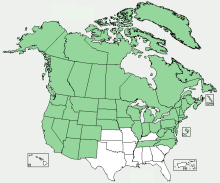Fireweed
Botanical name: Chamerion angustifolium
Family: Willowherb (Onagraceae)
Collectability: plentiful, common, widespread, weed
Main benefit
 source of Vitamin A and C
source of Vitamin A and C
Plant: soothing
Use - overview












Features and Identification
Habitat
Type: waste places
Distribution: throughout northern hemisphere
Other: patch forming; see Note [1] below
General
Growth type: herb
Cycle: perennial
Height: up to 2 meters
 Leaf
Leaf
Shape: lanceolate
Arrangement: alternate
Edge: smooth
 Root
Root
Type: rhizome
 Flower
Flower
Diameter: 20-30mm
Petals/sepals: 4, uneven
Arrangement: progressive on spike
Colour:
 Seed
Seed
Shape: with down
Size: tiny
Casing: long, pod-like tubes
Type: waste places
Distribution: throughout northern hemisphere
Other: patch forming; see Note [1] below
General
Growth type: herb
Cycle: perennial
Height: up to 2 meters
 Leaf
LeafShape: lanceolate
Arrangement: alternate
Edge: smooth
 Root
RootType: rhizome
 Flower
FlowerDiameter: 20-30mm
Petals/sepals: 4, uneven
Arrangement: progressive on spike
Colour:

 Seed
SeedShape: with down
Size: tiny
Casing: long, pod-like tubes
Distribution Map

When Available?
 March to July
March to July March to June
March to June all year - best March to May
all year - best March to May June to September
June to September July to October
July to OctoberParts with black and white icons are for non-culinary use
Culinary Use
Flavour
Rating and Description:

 bland
bland
How to Consume

 (young shoots)
(young shoots)  : raw
: raw
 raw, flour
raw, flour
Special preparation
 peel
peel
Nutrition
 Vitamin A and C
Vitamin A and C
Used as ...
 food, beverage, see Note [2] below
food, beverage, see Note [2] below
 shoots: food; pith: thickener
shoots: food; pith: thickener

 food
food
Rating and Description:

 bland
blandHow to Consume

 (young shoots)
(young shoots)  : raw
: raw raw, flour
raw, flourSpecial preparation
 peel
peelNutrition
 Vitamin A and C
Vitamin A and CUsed as ...
 food, beverage, see Note [2] below
food, beverage, see Note [2] below shoots: food; pith: thickener
shoots: food; pith: thickener
 food
food
Medicinal Use
Action:
Plant: anticancer, anti-inflammatory, antispasmodic, astringent, demulcent, emollient, laxative, tonic
 (peeled): may be antimalerial
(peeled): may be antimalerial
May treat:
Plant: candida, diarrhoea, mucous colitis, irritable bowel syndrome, abdominal cramps, skin/mouth ulcers, prostate (especially cancer of the prostate)
 poultice: burns, skin sores, swelling, boils
poultice: burns, skin sores, swelling, boils
Plant: anticancer, anti-inflammatory, antispasmodic, astringent, demulcent, emollient, laxative, tonic
 (peeled): may be antimalerial
(peeled): may be antimalerialMay treat:
Plant: candida, diarrhoea, mucous colitis, irritable bowel syndrome, abdominal cramps, skin/mouth ulcers, prostate (especially cancer of the prostate)
 poultice: burns, skin sores, swelling, boils
poultice: burns, skin sores, swelling, boils
Other Use
 down: tinder, pillow stuffing
down: tinder, pillow stuffing
Collection, Storing and Notes
Drying

 dry about 10 days by hanging (not flowering plants)
dry about 10 days by hanging (not flowering plants)
Note
[1] Despite the fact that this plant often follows fire, it is not the heat which is required but bare ground, as the seed needs light to germinate. It will colonise any freshly opened ground, and subsequently spread by rhizome.
[2] Not suitable for leaf curd, as the juice has a thick, mucilaginous consistency.
[3] Food for the Elephant Hawk Moth caterpillar.

 dry about 10 days by hanging (not flowering plants)
dry about 10 days by hanging (not flowering plants)Note
[1] Despite the fact that this plant often follows fire, it is not the heat which is required but bare ground, as the seed needs light to germinate. It will colonise any freshly opened ground, and subsequently spread by rhizome.
[2] Not suitable for leaf curd, as the juice has a thick, mucilaginous consistency.
[3] Food for the Elephant Hawk Moth caterpillar.
Key
Plant parts:
 leaf
leaf
 stem or trunk
stem or trunk
 sap
sap
 root, bulb, tuber and other below ground parts
root, bulb, tuber and other below ground parts
 flower
flower
 fruit
fruit
 seed
seed
Parts with black and white icons in the availability section are for non-culinary use
Use:
 culinary use
culinary use
 medicinal use
medicinal use
 household use
household use
Other:
 caution
caution
 leaf
leaf stem or trunk
stem or trunk sap
sap root, bulb, tuber and other below ground parts
root, bulb, tuber and other below ground parts flower
flower fruit
fruit seed
seedParts with black and white icons in the availability section are for non-culinary use
Use:
 culinary use
culinary use medicinal use
medicinal use household use
household useOther:
 caution
caution
Glossary
General Glossary
Glossary of Medicinal Terms and Nutritive Substances
- lanceolate: shaped like a lance head; long, tapering to end
Glossary of Medicinal Terms and Nutritive Substances
- anti-inflammatory: reduces inflammation of joints, injuries etc. (see also demulcent, emollient)
- antispasmodic: prevents or eases spasms or cramps
- astringent: causes localised contraction of blood vessels and tissue, reducing the flow of blood, mucus, diarrhoea etc.
- demulcent: rich in mucilage, soothes or protects irritated or inflamed tissue (especially mucousa)
- emollient: applied to the skin softens, soothes, protects (externally, as demulcents do internally)
- laxative: evacuates the bowels or softens stools
- tonic: improves general health, bringing steady improvement




